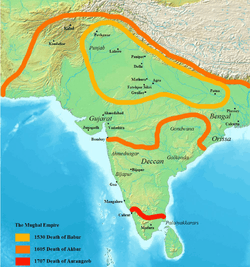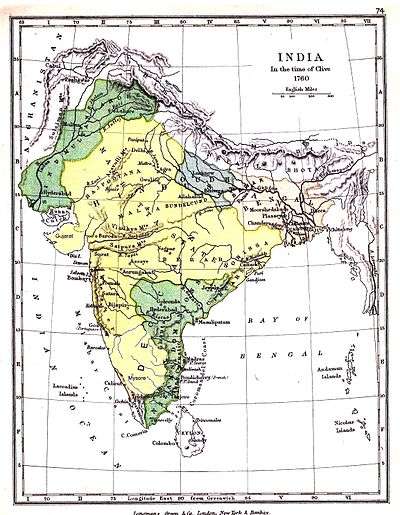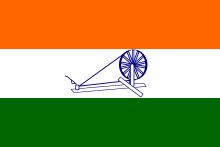Indian nationalism
Indian nationalism refers to the many underlying forces that defined the principles of the Indian independence movement, and strongly continue to influence the politics of India, as well as being the heart of many contrasting ideologies that have caused ethnic and religious conflict in Indian society. Indian nationalism often imbibes the consciousness of Indians that prior to 1947, India embodied the broader Indian subcontinent and influenced a part of Asia, known as Greater India.
National consciousness in India

India has been unified under many emperors and governments in history. Ancient texts mention India under emperor Bharata and Akhand Bharat, these regions roughly form the entities of modern-day greater India. The Mauryan Empire was the first to unite all of India, and South Asia (including much of Afghanistan).[1] In addition, much of India has also been unified under a central government by empires, such as the Gupta Empire, Rashtrakuta Empire, Pala Empire, Mughal Empire, Indian Empire etc.
Conception of Pan-South Asianism
India's concept of nationhood is based not merely on territorial extent of its sovereignty. Nationalistic sentiments and expression encompass that India's ancient history,[2] as the birthplace of the Indus Valley Civilization and Vedic Civilization, as well as four major world religions – Hinduism, Buddhism, Jainism and Sikhism. Indian nationalists see India stretching along these lines across the Indian Subcontinent.
Ages of war and invasion


India today celebrates many kings and queens for combating foreign invasion and domination,[3] such as Shivaji of the Maratha Empire, Rani Laxmibai of Jhansi, Kittur Chennamma, Maharana Pratap of Rajputana, Prithviraj Chauhan and Tipu Sultan who fought the British. The kings of Ancient India, such as Chandragupta Maurya and Ashoka of the Magadha Empire, are also remembered for their military genius, notable conquests and remarkable religious tolerance.
Muslim kings are also a part of Indian pride.[3] Akbar was a powerful Mughal emperor who sought to resolve religious differences, and was known to have a good relationship with the Roman Catholic Church as well as with his subjects – Hindus, Buddhists, Sikhs and Jains. He forged familial and political bonds with Hindu Rajput kings. Although previous Sultans had been more or less tolerant, Akbar took religious intermingling to new level of exploration. He developed for the first time in Islamic India an environment of complete religious freedom. Akbar undid most forms of religious discrimination, and invited the participation of wise Hindu ministers and kings, and even religious scholars to debate in his court.
Colonial-era nationalism

The consolidation of the British East India Company's rule in the Indian subcontinent during the 18th century brought about socio-economic changes which led to the rise of an Indian middle class and steadily eroded pre-colonial socio-religious institutions and barriers.[4] The emerging economic and financial power of Indian business-owners and merchants and the professional class brought them increasingly into conflict with the British Raj. A rising political consciousness among the native Indian social elite (including lawyers, doctors, university graduates, government officials and similar groups) spawned an Indian identity[5][6] and fed a growing nationalist sentiment in India in the last decades of the nineteenth century.[7] The creation in 1885 of the Indian National Congress in India by the political reformer A.O. Hume intensified the process by providing an important platform from which demands could be made for political liberalisation, increased autonomy, and social reform.[8] The leaders of the Congress advocated dialogue and debate with the Raj administration to achieve their political goals. Distinct from these moderate voices (or loyalists) who did not preach or support violence was the nationalist movement, which grew particularly strong, radical and violent in Bengal and in Punjab. Notable but smaller movements also appeared in Maharashtra, Madras and other areas across the south.[8]
Swadeshi
The controversial 1905 partition of Bengal escalated the growing unrest, stimulating radical nationalist sentiments and becoming a driving force for Indian revolutionaries.[9]
The Gandhian era
Mohandas Gandhi pioneered the art of Satyagraha, typified with a strict adherence to ahimsa (non-violence), and civil disobedience. This permitted common individuals to engage the British in revolution, without employing violence or other distasteful means. Gandhi's equally strict adherence to democracy, religious and ethnic equality and brotherhood, as well as activist rejection of caste-based discrimination and untouchability united people across these demographic lines for the first time in India's history. The masses participated in India's independence struggle for the first time, and the membership of the Congress grew over tens of millions by the 1930s. In addition, Gandhi's victories in the Champaran and Kheda Satyagraha in 1918–19, gave confidence to a rising younger generation of Indian nationalists that the British Raj could be defeated. National leaders like Sardar Vallabhbhai Patel, Jawaharlal Nehru, Maulana Azad, Chakravarti Rajagopalachari, Mohandas Gandhi, Rajendra Prasad and Badshah Khan brought together generations of Indians across regions and demographics, and provided a strong leadership base giving the country political direction.
More than just "Indian"
Indian nationalism is as much a diverse blend of nationalistic sentiments as its people are ethnically and religiously diverse. Thus the most influential undercurrents are more than just Indian in nature. The most controversial and emotionally charged fibre in the fabric of Indian nationalism is religion. Religion forms a major, and in many cases, the central element of Indian life. Ethnic communities are diverse in terms of linguistics, social traditions and history across India.
Hindu Rashtra

An important influence upon Hindu consciousness arises from the time of Islamic empires in India. Entering the 20th century, Hindus formed over 75% of the population and thus unsurprisingly the backbone and platform of the nationalist movement. Modern Hindu thinking desired to unite Hindu society across the boundaries of caste, linguistic groups and ethnicity. In 1925, K.B. Hedgewar founded the Rashtriya Swayamsevak Sangh in Nagpur, Maharashtra, which grew into the largest civil organisation in the country, and more potent, mainstream base of Hindu nationalism.
Vinayak Damodar Savarkar coined the term Hindutva for his ideology that described India as a Hindu Rashtra, a Hindu nation. This ideology has become the cornerstone of the political and religious agendas of modern Hindu nationalist bodies like the Bharatiya Janata Party and the Vishwa Hindu Parishad. Hindutva political demands include revoking Article 370 of the Constitution that grants a special semi-autonomous status to the Muslim-majority state of Kashmir, adopting a uniform civil code, thus ending a special legal framework for Muslims. These particular demands are based upon ending laws that Hindu nationalists consider as offering special treatment to Muslims.
The Qaum
In 1906–1907, the All India Muslim League was founded, created due to the suspicion of Muslim intellectuals and religious leaders with the Indian National Congress, which was perceived as dominated by Hindu membership and opinions. However, Mahatma Gandhi's leadership attracted a wide array of Muslims to the independence struggle and the Congress Party. The Aligarh Muslim University and the Jamia Millia Islamia stand apart – the former helped form the Muslim league, while the JMI was founded to promote Muslim education and consciousness upon nationalistic and Gandhian values and thought.
While prominent Muslims like Allama Iqbal, Muhammad Ali Jinnah and Liaquat Ali Khan embraced the notion that Hindus and Muslims were distinct nations, other major leaders like Mukhtar Ahmed Ansari, Maulana Azad and most of Deobandi clerics strongly backed the leadership of Mahatma Gandhi and the Indian independence struggle, opposing any notion of Muslim nationalism and separatism. The Muslim school of Indian nationalism failed to attract Muslim masses and the Islamic nationalist Muslim League enjoyed extensive popular political support. State of Pakistan was ultimately formed following Partition of India
Nationalism and politics
The political identity of the Indian National Congress, India's largest political party and one which controlled government for over 45 years, is reliant on the connection to Mohandas K. Gandhi and Jawaharlal Nehru, and the Nehru-Gandhi family which has controlled the Congress since independence. The Congress Party's fortunes up till the 1970s were single-handedly propelled by its legacy as the flagship of India's Independence Movement, and the core platform of the party today evokes that past strongly, considering itself to be the guardian of India's independence, democracy and unity. Muslims have remained loyal voters of the Congress Party, seen as defender of Nehruvian secularism.[10] In contrast, the Bharatiya Janata Party employs a more aggressively nationalistic expression. The BJP seeks to preserve and spread the culture of the Hindus, the majority population. It ties nationalism with the aggressive defence of India's borders and interests against archrivals China and Pakistan, with the defence of the majority's right to be a majority.
Religious nationalist parties include the Shiromani Akali Dal, which is closely identified with the creation of a Sikh-majority state in Punjab and includes many Sikh religious leaders in its organisation. In Maharashtra, the Shiv Sena uses the legacy of the independent Maratha kingdom under famous figures like Shivaji to stir up support, and has adopted Hindutva as well. In Assam, the Asom Gana Parishad is a more state-focused party, arising after the frustration of the United Liberation Front of Asom (ULFA) as a benevolent expression of Assamese nationalism. In Tamil Nadu came the first of such parties, the Dravidar Kazhagam (DK). Today the DK stands for a collection of parties,[11] with the Dravida Munnetra Kazhagam (DMK), the All India Anna Dravida Munnetra Kazhagam (AIADMK), the Pattali Makkal Katchi (PMK) and the Marumalarchi Dravida Munnetra Kazhagam (MDMK). Caste-based politics invite the participation of the Bahujan Samaj Party and the party of Laloo Prasad Yadav, who build upon the support of poor low-caste and dalit Hindus in the northern, and most populated states of India like Uttar Pradesh and Bihar. Almost every Indian state has a regional party devoted solely to the culture of the native people of that state.
Nationalism and military conflicts

Military history, both past and present, serves as a source of nationalist sentiment in India. The first reference to armies is found in the Vedas and the epics Ramayana and Mahabaratha. There were many powerful dynasties in India such as the Maha Janapadas, Shishunaga Empire, Gangaridai Empire, Nanda Empire, Maurya Empire, Shunga Empire, Kharavela Empire, Kuninda Kingdom, Chola Empire, Chera Empire, Pandyan Empire, Satavahana Empire, Western Satrap Empire, Kushan Empire, Vakataka Empire, Kalabhras Kingdom, Gupta Empire, Pallava Empire, Kadamba Empire, Western Ganga Kingdom, Vishnukundina Empire, Chalukya Empire, Harsha Empire, Shahi Kingdom, Eastern Chalukya Kingdom, Pratihara Empire, Pala Empire, Rashtrakuta Empire, Paramara Kingdom, Yadava Empire, Solanki Kingdom, Western Chalukya Empire, Hoysala Empire, Sena Empire, Eastern Ganga Empire, Kakatiya Kingdom, Kalachuri Empire, Delhi Sultanate, Deccan Sultanates, Ahom Kingdom, Vijayanagar Empire, Mysore Kingdom, Mughal Empire, Maratha Empire, Sikh Empire etc.
The modern Army of India was raised under the British Raj in the 19th century. Today the Republic of India maintains the world's third largest armed forces with over a million troops strong.[12] The official defence budget stands at ₹1,644,151.9 million (US$24 billion)[13] but the actual spending on the armed forces is estimated to be much higher.[14] The army is undergoing rapid expansion and modernisation[15] with plans to have an active military space program,[16] missile defence shield,[17] and nuclear triad capability.[18]
See also
References
- ↑ "Afghanistan Country Study Guide Volume 1 Strategic Information and Developments geredigeerd door Inb, Inc". Retrieved 27 February 2015.
- ↑ Acharya, Shiva. "Nation, Nationalism and Social Structure in Ancient India By Shiva Acharya". Sundeepbooks.com. Retrieved 2011-11-17.
- 1 2 "Mahrattas, Sikhs and Southern Sultans of India : Their Fight Against Foreign Power/edited by H.S. Bhatia". Vedamsbooks.com. Retrieved 2011-11-17.
- ↑ Mitra 2006, p. 63
- ↑ Croitt & Mjøset 2001, p. 158
- ↑ Desai 2005, p. xxxiii
- ↑ Desai 2005, p. 30
- 1 2 Yadav 1992, p. 6
- ↑ Bose & Jalal 1998, p. 117
- ↑ "Character of Nehruvian Secularism". Bharatvani.org. Retrieved 2011-11-17.
- ↑ "Tamil Nadu / Madurai News : Vijaykanth slams Dravidian parties". The Hindu. 8 January 2009. Retrieved 2011-11-17.
- ↑ "A Thomson Reuters Foundation Service". AlertNet. Retrieved 2011-11-17.
- ↑ "Defence Budget 2011–12 – Misplaced Euphoria – India Defence – Security Trends South Asia – Security-Risks.com Caring for your Safety, Life & Security". Security-risks.com. 2 March 2011. Retrieved 2011-11-17.
- ↑ Business Standard (11 March 2008). "Ajai Shukla: How much is the defence budget?". Business-standard.com. Retrieved 2011-11-17.
- ↑ Greenlees, Donald (19 September 2007). "China and India leading Asian missile buildup – The New York Times". International Herald Tribune. Retrieved 2011-11-17.
- ↑ Gavin Rabinowitz, Associated Press (18 June 2008). "India's army seeks military space program". Sfgate.com. Retrieved 2011-11-17.
- ↑ India successfully tests missile interceptor
- ↑ TNN, 27 February 2008, 12:34 am IST (27 February 2008). "India test fires submarine-launched ballistic missile – India – The Times of India". Timesofindia.indiatimes.com. Retrieved 2011-11-17.
